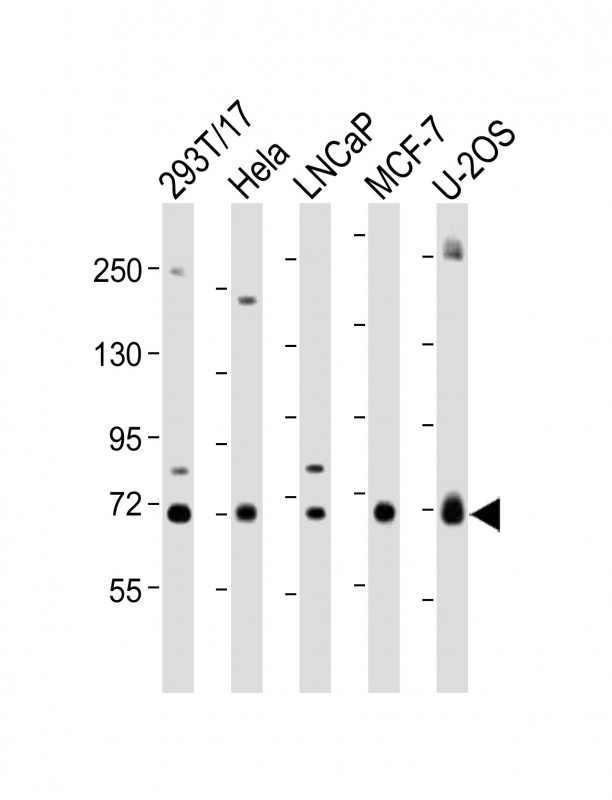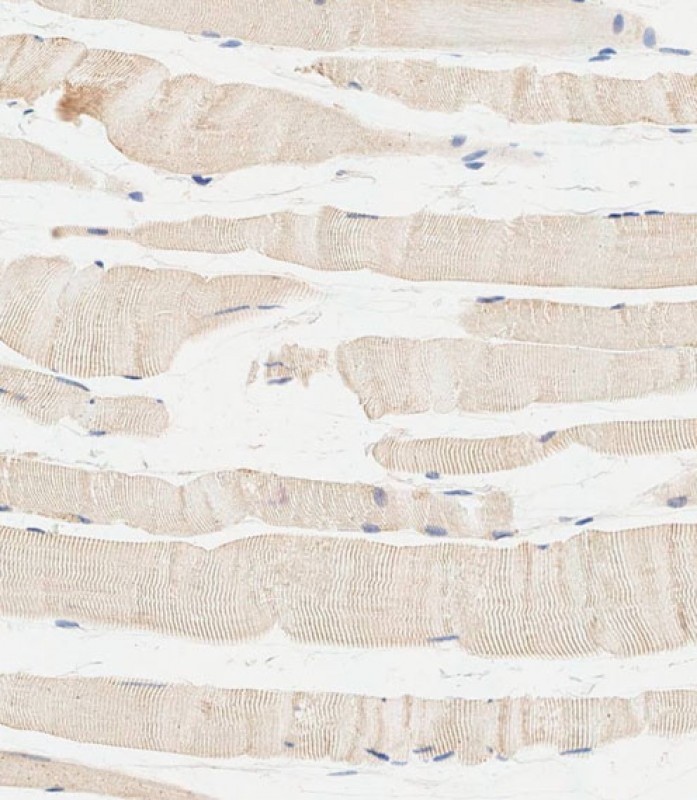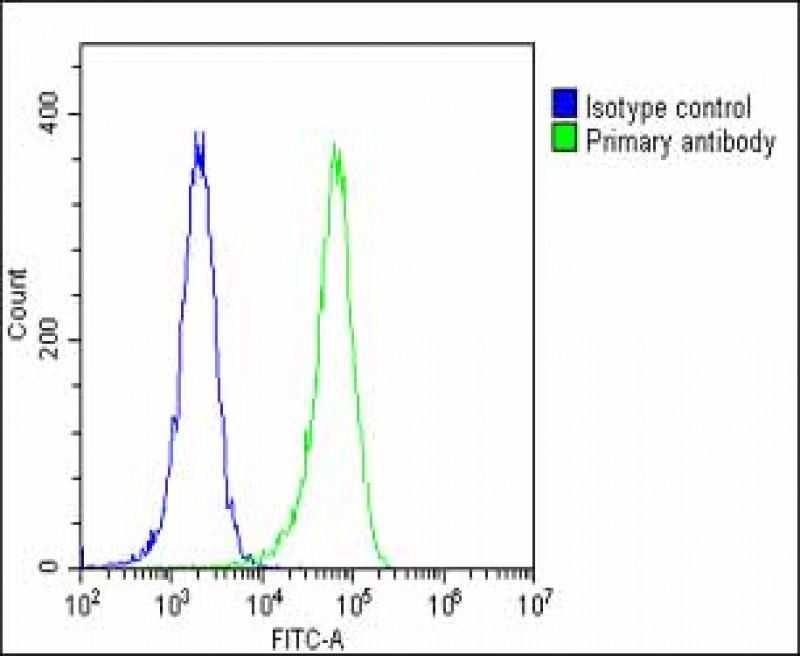GC Antibody (Center)
Affinity Purified Rabbit Polyclonal Antibody (Pab)
- SPECIFICATION
- CITATIONS
- PROTOCOLS
- BACKGROUND

Application
| WB, FC, IHC-P-Leica, E |
|---|---|
| Primary Accession | P04062 |
| Other Accession | Q70KH2, Q2KHZ8 |
| Reactivity | Human, Mouse |
| Predicted | Bovine, Pig |
| Host | Rabbit |
| Clonality | Polyclonal |
| Isotype | Rabbit IgG |
| Calculated MW | 59716 Da |
| Antigen Region | 337-365 aa |
| Gene ID | 2629 |
|---|---|
| Other Names | Glucosylceramidase, Acid beta-glucosidase, Alglucerase, Beta-glucocerebrosidase, Beta-GC, D-glucosyl-N-acylsphingosine glucohydrolase, Imiglucerase, GBA, GC, GLUC |
| Target/Specificity | This GC antibody is generated from rabbits immunized with a KLH conjugated synthetic peptide between 337-365 amino acids of human GC. |
| Dilution | WB~~1:2000 FC~~1:25 IHC-P-Leica~~1:500 E~~Use at an assay dependent concentration. |
| Format | Purified polyclonal antibody supplied in PBS with 0.09% (W/V) sodium azide. This antibody is purified through a protein A column, followed by peptide affinity purification. |
| Storage | Maintain refrigerated at 2-8°C for up to 2 weeks. For long term storage store at -20°C in small aliquots to prevent freeze-thaw cycles. |
| Precautions | GC Antibody (Center) is for research use only and not for use in diagnostic or therapeutic procedures. |
| Name | GBA1 (HGNC:4177) |
|---|---|
| Synonyms | GBA, GC, GLUC |
| Function | Glucosylceramidase that catalyzes, within the lysosomal compartment, the hydrolysis of glucosylceramides/GlcCers (such as beta- D-glucosyl-(1<->1')-N-acylsphing-4-enine) into free ceramides (such as N-acylsphing-4-enine) and glucose (PubMed:15916907, PubMed:24211208, PubMed:32144204, PubMed:9201993). Plays a central role in the degradation of complex lipids and the turnover of cellular membranes (PubMed:27378698). Through the production of ceramides, participates in the PKC-activated salvage pathway of ceramide formation (PubMed:19279011). Catalyzes the glucosylation of cholesterol, through a transglucosylation reaction where glucose is transferred from GlcCer to cholesterol (PubMed:24211208, PubMed:26724485, PubMed:32144204). GlcCer containing mono-unsaturated fatty acids (such as beta-D- glucosyl-N-(9Z-octadecenoyl)-sphing-4-enine) are preferred as glucose donors for cholesterol glucosylation when compared with GlcCer containing same chain length of saturated fatty acids (such as beta-D- glucosyl-N-octadecanoyl-sphing-4-enine) (PubMed:24211208). Under specific conditions, may alternatively catalyze the reverse reaction, transferring glucose from cholesteryl 3-beta-D-glucoside to ceramide (Probable) (PubMed:26724485). Can also hydrolyze cholesteryl 3-beta-D- glucoside producing glucose and cholesterol (PubMed:24211208, PubMed:26724485). Catalyzes the hydrolysis of galactosylceramides/GalCers (such as beta-D-galactosyl-(1<->1')-N- acylsphing-4-enine), as well as the transfer of galactose between GalCers and cholesterol in vitro, but with lower activity than with GlcCers (PubMed:32144204). Contrary to GlcCer and GalCer, xylosylceramide/XylCer (such as beta-D-xyosyl-(1<->1')-N-acylsphing-4- enine) is not a good substrate for hydrolysis, however it is a good xylose donor for transxylosylation activity to form cholesteryl 3-beta- D-xyloside (PubMed:33361282). |
| Cellular Location | Lysosome membrane; Peripheral membrane protein; Lumenal side. Note=Interaction with saposin-C promotes membrane association (PubMed:10781797). Targeting to lysosomes occurs through an alternative MPR-independent mechanism via SCARB2 (PubMed:18022370). |

Thousands of laboratories across the world have published research that depended on the performance of antibodies from Abcepta to advance their research. Check out links to articles that cite our products in major peer-reviewed journals, organized by research category.
info@abcepta.com, and receive a free "I Love Antibodies" mug.
Provided below are standard protocols that you may find useful for product applications.
Background
GC is a protein that cleaves the beta-glucosidic linkage of glycosylceramide, an intermediate in glycolipid metabolism.
References
Jamrozik,Z., et.al., J. Neurol. 257 (3), 459-460 (2010)
Mao,X.Y., et.al., Neurosci. Lett. 469 (2), 256-259 (2010)
If you have used an Abcepta product and would like to share how it has performed, please click on the "Submit Review" button and provide the requested information. Our staff will examine and post your review and contact you if needed.
If you have any additional inquiries please email technical services at tech@abcepta.com.













 Foundational characteristics of cancer include proliferation, angiogenesis, migration, evasion of apoptosis, and cellular immortality. Find key markers for these cellular processes and antibodies to detect them.
Foundational characteristics of cancer include proliferation, angiogenesis, migration, evasion of apoptosis, and cellular immortality. Find key markers for these cellular processes and antibodies to detect them. The SUMOplot™ Analysis Program predicts and scores sumoylation sites in your protein. SUMOylation is a post-translational modification involved in various cellular processes, such as nuclear-cytosolic transport, transcriptional regulation, apoptosis, protein stability, response to stress, and progression through the cell cycle.
The SUMOplot™ Analysis Program predicts and scores sumoylation sites in your protein. SUMOylation is a post-translational modification involved in various cellular processes, such as nuclear-cytosolic transport, transcriptional regulation, apoptosis, protein stability, response to stress, and progression through the cell cycle. The Autophagy Receptor Motif Plotter predicts and scores autophagy receptor binding sites in your protein. Identifying proteins connected to this pathway is critical to understanding the role of autophagy in physiological as well as pathological processes such as development, differentiation, neurodegenerative diseases, stress, infection, and cancer.
The Autophagy Receptor Motif Plotter predicts and scores autophagy receptor binding sites in your protein. Identifying proteins connected to this pathway is critical to understanding the role of autophagy in physiological as well as pathological processes such as development, differentiation, neurodegenerative diseases, stress, infection, and cancer.





